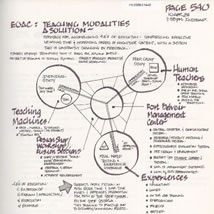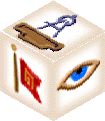Work
Integrated Education |
Building
an Education Engine |
| In
1983, we did a DesignShop® event with the Corps of Engineers.
Their problem was both systemic and directly related
to the rate of change problem. |
The
condition that the Army faced at the time, was
that a third of the Army was trained and equipped
in one
battle doctrine, a third in another and, yet
another. It took, at that time, 6 years from the
creation
of a new doctrine before new training could be
put in
place and substantially delivered. The first
three of those years were made of of the planning
and
approval process. Battle doctrines were changing
faster than
the troops could
be educated.
At this moment, a new approach to warfare emerged
called “The Air Land Battle.” This
called for combined operations, capable of fighting
a deep
penetration,
full parameter, 24/7 battle divorced from central
command control in the ABC environment.
(note:
the first example of anything approaching this battle
style is the 2003 second
war with Iraq)
|
| The
Air Land Battle Doctrine was not just another doctrine
on top of the previous three; it constituted
a difference in kind as well as magnitude.
The Army needed a new way of training and it needed
it fast. |
| The
Corps did a five day DesignShop® process in Boulder,
ending on a Saturday. By the next Wednesday they
had briefed it to the Army Chief and gotten approval;
with in 9 months new instruction was under way. The
Corps of Engineers built a NavCenter - they called
it a Fusion Center - at Ft. Belvoir outside of Washington
DC which they used to implement their plan. Ultimately,
the way they implemented became a model for training across \the entire
US Army. |
|
 |
The
Army not only wanted to do training faster, they
wanted to do it in a better way. I
developed a model for them, based on Gail’s
and my prior
work, that combined three different modes of
learning into an
integrated
system of individualized, continuous
professional growth.
|
|
| The Teaching
Modalities Model describes five components
of a life-long, institutionalized education delivery
system: self-paced, computer aided learning; human
mentoring by subject experts delivered by one-on-one
coaching and by dialog with teams of peers; intimate
and high frequency connection to the daily work
experience - all integrated
by a NavCenter that provides collaborative learning
and creative tools and processes. The personalized
integration of all these components is provided
by the Capacity Guide - a system that
matches work opportunities to demonstrable skill
levels,
study programs and the Curriculum of the 21st
Century. This sums up to the practice of a
systematic lifelong learning model with the learner
progressively
becoming
the master of the education process. |
| A
successful leaning institution will embed these
modalities into their content, process, tooling and
physical
environment thus making a seamless, integrated system
that addresses the entire cycle of thought to building
to use: from the gathering of insights, to necessary
real time skill building, to the act of producing
creative
work in the real world. |
|
Matt
Taylor
Palo Alto
March 3, 2001

SolutionBox
voice of this document:
VISION • STRATEGY • SCHEMATIC
|
|
posted:
March 3, 2001
revised:
April 16, 2003
• 200100303.282435.mt • 20030416.212259.mt •
(note:
this document is about 10% finished)
Matt
Taylor 650 814 1192
me@matttaylor.com
Copyright© Matt
Taylor 1983, 2001, 2003 |
|
|